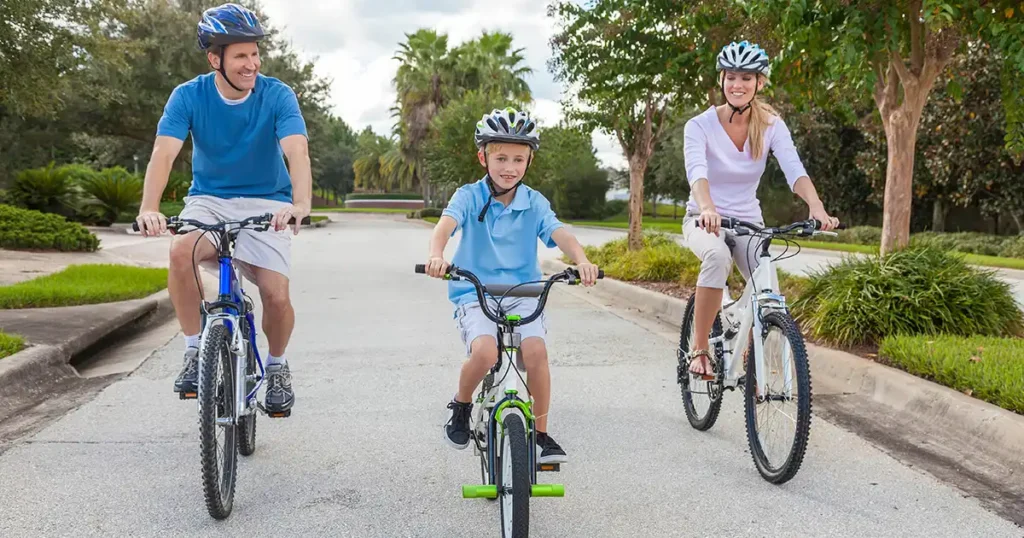Cycling is an enjoyable and environmentally friendly way to stay active, explore your surroundings, and get from one place to another. Whether you’re commuting to work, enjoying a leisurely ride through the park, or tackling a challenging mountain trail, safety should always be a top priority. With the right precautions, you can reduce the risk of accidents and have a safe and pleasant ride every time you hit the road.
In this blog, we’ll share essential safety tips for cyclists that will help you ride safely and confidently, no matter where you’re headed.
1. Always Wear a Helmet
Wearing a helmet is one of the most important steps you can take to protect yourself while cycling. Helmets are designed to absorb impact and reduce the risk of serious head injuries in case of an accident.
Why It’s Important:
-
Protection: In the event of a fall or collision, a helmet can significantly reduce the risk of brain injuries, concussions, and skull fractures.
-
Legal requirement: In many areas, wearing a helmet is required by law for cyclists, especially for children.
Tips for Helmet Safety:
-
Choose the right helmet: Ensure your helmet fits properly—secure it tightly without it being too tight. It should sit level on your head and cover your forehead.
-
Replace when necessary: If you’ve been in an accident, or if your helmet is cracked or damaged, replace it immediately to ensure maximum protection.
2. Make Yourself Visible to Others
Visibility is key to preventing accidents, especially if you’re riding at night, in low-light conditions, or in traffic-heavy areas. Drivers may not always see cyclists, so it’s important to make yourself as visible as possible.
Why It’s Important:
-
Accidents often happen due to poor visibility: Cyclists can be difficult for drivers to spot, especially in dark or foggy conditions.
-
Night riding: If you ride during the evening or night, having the right gear can prevent dangerous accidents.
Tips for Staying Visible:
-
Wear bright or reflective clothing: Choose brightly colored clothing, or better yet, wear reflective gear such as vests or arm bands. Bright colors like neon yellow or orange are particularly visible.
-
Use bike lights: Front and rear lights are essential for night riding. A white light in the front and a red light in the back help you see the road and make you more visible to drivers. Consider using flashing lights for maximum visibility.
-
Reflective accessories: Add reflective tape to your bike, helmet, and gear to increase visibility in low-light conditions.
3. Obey Traffic Laws
Cyclists have the same rights and responsibilities as other road users. Obeying traffic laws not only keeps you safe but also ensures you’re riding legally.
Why It’s Important:
-
Prevent collisions: Following traffic rules, such as stopping at red lights and using hand signals, helps prevent accidents.
-
Respect for others: By obeying the rules of the road, you show respect for other cyclists, pedestrians, and drivers.
Tips for Obeying Traffic Laws:
-
Follow traffic signals and signs: Always stop at red lights and stop signs. Yield to pedestrians at crosswalks, and follow any bike lane signs or rules.
-
Signal your turns: Use hand signals to let drivers know when you’re turning or changing lanes. This communication helps everyone stay safe on the road.
-
Ride in the same direction as traffic: Always ride in the same direction as traffic, not against it. This makes you more visible and reduces the risk of accidents.
4. Keep Your Bike in Good Condition
Regular maintenance ensures that your bike is in optimal working condition and can prevent mechanical failures that might lead to accidents.
Why It’s Important:
-
Prevent mechanical failures: A bike that’s poorly maintained can malfunction while you’re riding, leading to dangerous situations, especially when braking or steering.
-
Ride smoothly and safely: A well-maintained bike provides a smooth, controlled ride and helps you avoid accidents caused by faulty components.
Tips for Bike Maintenance:
-
Check tire pressure: Ensure your tires are inflated to the proper pressure, as specified by the manufacturer. Underinflated tires can cause poor handling and increase the risk of flats.
-
Inspect brakes regularly: Test your brakes before every ride to ensure they’re responsive. If they feel weak or unresponsive, get them adjusted or replaced immediately.
-
Clean and lubricate your chain: A clean, well-lubricated chain improves the bike’s performance and makes pedaling easier. Regularly wipe down your chain and apply bike-specific lubricant.
5. Ride Defensively and Stay Aware of Your Surroundings
Cyclists are vulnerable to accidents, especially when sharing the road with larger vehicles. Riding defensively and staying aware of your surroundings will help you anticipate potential hazards and avoid them.
Why It’s Important:
-
Accidents happen quickly: Riding defensively means being prepared for unexpected situations and avoiding risky maneuvers.
-
Awareness keeps you safe: Being mindful of other road users, including pedestrians and drivers, helps you make safer decisions while riding.
Tips for Defensive Riding:
-
Stay alert: Keep an eye out for potential hazards like potholes, road debris, and other obstacles. Pay attention to traffic and pedestrians, and be aware of any vehicles that may be merging or turning.
-
Keep a safe distance: Maintain a safe distance from other vehicles, cyclists, and obstacles. Don’t ride too close to parked cars, as doors may open unexpectedly.
-
Use both hands: Always keep both hands on the handlebars unless signaling or adjusting something. This ensures you maintain control of your bike at all times.
-
Avoid distractions: Don’t use headphones or a phone while riding, as these can distract you from your surroundings.
6. Use Proper Riding Techniques
How you ride can significantly impact your safety. Proper techniques help you maintain control of your bike and navigate safely through traffic or rough terrain.
Why It’s Important:
-
Better control: Using the right riding posture and technique helps you maintain better control over your bike, especially in challenging conditions.
-
Reduce fatigue: Proper riding form reduces the strain on your body, allowing you to ride longer and more comfortably.
Tips for Proper Riding Techniques:
-
Keep your posture relaxed: Keep your elbows slightly bent and your hands relaxed on the handlebars. This will allow for better control and flexibility in case you need to react quickly.
-
Pedal efficiently: Focus on pedaling in smooth, consistent strokes. Avoid jerky motions that could lead to loss of control or fatigue.
-
Look ahead: Always keep your eyes on the road ahead to anticipate obstacles or changes in traffic. Looking ahead helps you react more quickly and maintain control.
Final Thoughts
Cycling is an incredibly rewarding and enjoyable activity, but safety should always be a priority. By following these essential safety tips—wearing a helmet, staying visible, obeying traffic laws, maintaining your bike, riding defensively, and using proper riding techniques—you can ensure that your cycling experience is not only enjoyable but safe.
Remember, being proactive about safety not only protects you but also helps make cycling safer for everyone on the road. Whether you’re a casual cyclist or an avid rider, these safety measures will help you enjoy your rides with confidence and peace of mind. Happy cycling!

